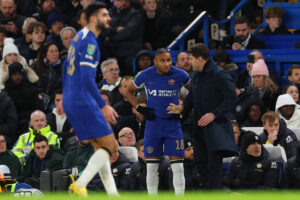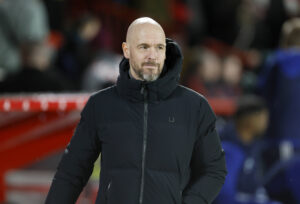Chelsea manager Antonio Conte has the Blues at the top of the Premier League table, nine points clear of second-place Tottenham. A comfortable 3-1 victory against Arsenal this past weekend displayed incredible form and a sharp understanding of what the Italian tactician wants to see from his squad.
Trading Places: Antonio Conte’s Formation At Different Clubs
A great deal of Chelsea’s success this season has been attributed to their formation change, as Conte’s switch to a 3-4-3 has been a catalyst for success. Positive results often yield the same modifications from the competition around a football club, and the Premier League is certainly no exception.
From “gegenpressing” to “tiki-taka”, imitation is the sincerest form of flattery.
While each side has unique strengths and weaknesses from their players that can dictate how an approach is crafted, it is interesting to imagine what could take place if others in the English top flight utilised Chelsea’s design.
Would it be effective? Would it lead to more victories? Would it be an absolute disaster?
Many of Chelsea’s players fit the scheme perfectly. David Luiz in the middle of a three-man defensive line, N’Golo Kante’s surreal work rate and Eden Hazard’s ability to create space all drive the 3-4-3 forward.
We examine Chelsea’s Premier League competition and review if there would be many positives to this adaptation of play.
Tottenham
Four at the back is almost mandatory in the English first division, as the pace of the Premier League can tear apart a three-man line. Tottenham boast one of the best, as well as a successful record.
With only two losses thus far this season and talented goalkeeper Hugo Lloris in sparkling form, Spurs’ defensive shape would certainly not want to be modified. The interesting aspect would be the front-line, as striker Harry Kane normally operates on his own with attacking midfielders joining in.
Toby Alderweireld has the ability to control the middle on the back-line and Victor Wanayama can be superb in a holding position, but manager Mauricio Pochettino would be bunched in the midfield. Christian Eriksen, Son Heung-Min, Dele Alli or Erik Lamela could play higher up the pitch but would all ultimately not be as effective.
Tottenham would truly be the least likely to implement a 3-4-3 formation.
Manchester City
Manchester City manager Pep Guardiola possesses limitless intangibles that make him successful, and could find success with almost any philosophy. With his current City line-up, a 3-4-3 formation would see exciting and electric play in the attack.
Midfielders like Raheem Sterling, Kevin De Bruyne, David Silva and Jesus Navas are spread across all angles of the pitch. Sergio Aguero leading a front-line with Gabriel Jesus and Leroy Sane. Suddenly, there are visions of scoring five or six goals per match coming to mind.
But the dreams become reality at the back for City within this entertaining thought. John Stones alone in central defence could be trouble, especially as goalkeepers Claudio Bravo and Willy Caballero struggle.
Ultimately, Guardiola would be taking far too great a risk to move more players forward in his line-up.
Arsenal
“Change” is a popular topic this week after Arsenal were thoroughly dominated at Stamford Bridge Saturday against Chelsea. However, similar to Tottenham, manager Arsene Wenger would not want to lose a strong back-line.
Pushing three forward in the attack would certainly bring a positive impact. Alexis Sanchez, Olivier Giroud, Danny Welbeck and Theo Walcott could all find space and create havoc in the final third. Mesut Ozil pulling the strings with sharp passing could open up the opposition’s defence.
Laurent Koscielny, Shkodran Mustafi and Hector Bellerin could work along the back-line. However, considering goalkeeper Petr Cech’s last performance, more defenders would be a welcome sight.
The Gunners are under quite a bit of pressure this week to see positive changes, but it would not come from a 3-4-3 formation.
Liverpool
Along a similar path, Liverpool and manager Jurgen Klopp need to see better results. And quickly.
Through ten matches across all competitions, the Reds have won only one thus far in 2017. Saturday’s 2-0 loss at Hull City was surprising, as the home side looked comfortable stopping the Liverpool attack.
Klopp normally uses three on the front-line, but defenders have had difficulties at the back already. James Milner could help in the midfield when needed. Captain Jordan Henderson, Adam Lallana, Emre Can and Georginio Wijnaldum would be a talented starting combination. The high-press system would then see multiple skilled attackers overwhelming the opposition.
The negatives would see a defence that struggles on the counter-attack and a further reliance on goalkeeping performances that have not been up to standard.
Manchester United
Manchester United have been gaining ground in the league table with improved form, and manager Jose Mourinho has never been shy about shifting his approach or formations in the past.
The influence would truly be felt in the midfield, where Mourinho could deploy more creative power. Juan Mata, Henrikh Mkhitaryan and Paul Pogba could all start, instead of Mata or Mkhitaryan occasionally being used as a substitute. Alternatively this season, Wayne Rooney can provide that depth moving ahead.
The attack utilises Anthony Martial with Zlatan Ibrahimovic and Marcus Rashford as well.
The back-line would depend heavily on Chris Smalling, Eric Bailly or Daley Blind centrally. Antonio Valencia’s contributions from the right-back position may be lost in the shuffle also. But with Ander Herrera in a defensive midfield position and the stellar goalkeeping of David de Gea, it is an experiment that United could see success with.
Trends in world football come and go, with Chelsea’s current line-up sitting atop the Premier League. The interesting aspect will be how far the Blues’ 3-4-3 formation carries in 2017.
Main Photo:






